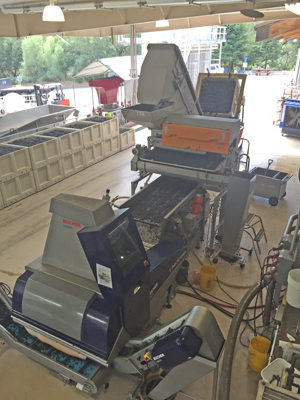MOG Blog
More than just the Chardonnay at Rombauer
Earlier this month I visited Rombauer Vineyards to check out the winery’s spruced up barrel caves that are the focus of a new tour and tasting at the venerable Napa Valley winery, which has long enjoyed a loyal following for its full-bodied Chardonnay.
Koerner Rombauer founded the winery in 1982 and still lives on the estate, while his son KR Rombauer and daughter Sheana Rombauer serve on the winery’s board of directors. The Rombauers originally dug the caves between 1996 to 1998, and they just spent about two years securing the necessary permits and making upgrades so the cave could be used for hospitality. The improvements included ADA enhancements, better lighting and a fire-suppression sprinkler system.
The caves span 1,900 linear feet, and the tour includes several stops to taste a different wines from the Rombauer’s lineup. When I visited we tried the famous Chardonnay as well as Bordeaux blend Le Meilleur du Chai, a couple of estate Cabernets and a Zinfandel from the Sierra Foothills. Our friends and colleagues over at Wine Business Monthly blogged about the new tour as well.
While not a new Napa Valley experience, Rombauer’s cave tour highlights the winery’s red wines, which have long been overshadowed by the commercial success of its Chardonnay. The winery produces about 200,000 cases per year and about two thirds of that is Chardonnay. All of the winery’s Chardonnay is barrel fermented at a separate facility near the Napa County Airport.
The hilltop winery, however, is focused on small-lot red wine production. Richie Allen, Rombauer’s director of viticulture and winemaking, has been with the winery since 2004, when he started as a harvest intern.
Starting in 2010, Allen has made a significant commitment to barrel fermenting the reds. When I visited, the walls of the cave were lined with dozens of brand new barrels from Tonnellerie Baron. The barrels have small, stainless steel ports fitted in the heads that are designed to make filling them with destemmed berries much easier. The other, more laborious method is removing a barrel head, and the team at Rombauer uses both methods. Barrel filling takes place on the crush pad with a unique two-spout funnel that pours the berries directly into the barrels.
Filled barrels ferment and age on OXOline racks that are equipped with rollers. During fermentation, which takes place in rooms that can be heated and not the cave, the racks make it easy to roll the barrels to break up the cap. During the rest of the year, the racks make all the other barrel jobs done in the cave a bit easier.
All of the grapes for the winery’s 2013 Stice Lane Vineyard Cabernet Sauvignon are fermented in barrels, and the wine exhibited the well-integrated oak that is the hallmark of the method. Early exposure to oak is also thought to help enhance color and tannin; the Stice Lane Cab had plenty of both, but the wine was far from over extracted and the tannins weren’t harsh at all.
On the crush pad, the grapes undergo a thorough and almost completely automated sorting process. Half-ton bins are dumped into a hopper that feeds an elevated conveyor dumping into a Pellenc destemmer. The destemmed grapes are then further sorted with a Bucher Vaslin Delta R2 Vistalys optical sorter before being pumped to stainless steel tanks with a peristaltic pump. (I spoke with Allen about peristaltic presses for a Product Focus feature scheduled for the November issue of Wines & Vines.) The winery also has a Pellenc optical sorter for the other red grape sorting and processing line.
New for this vintage, the winery installed dedicated pump-over pumps for most of its red wine fermentation tanks. The winemaking team also uses a new TankNet system to control those pumps as well as monitor and adjust tank temperature.
During my visit, the production team was busy unloading bins of El Dorado County Zinfandel, which had come to the winery in a refrigerated truck. Associate winemaker Luke Clayton told me fruit quality has been consistently good, with yields running from average to a little less than average. It was about the midway point of the crush when I was there in mid-September.
And the Chardonnay? It’s still big and rather lush but not as overpowering as I remembered. It had been a few years since I last tried the wine, and I found the 2015 Carneros Chardonnay to be a big malo and new oak wine, but the finish was much crisper than I recalled and the wine seemed more balanced in general. It occurred to me perhaps that there are other, more subtle changes at Rombauer than just the new cave tour.
- Portraits in cork 07.07.2017
- Did you learn the lessons of the Napa earthquake? 06.08.2017
- Bucking the $10 and up premiumization trend 06.05.2017
- Wine in cans, not the next Moscato 05.31.2017
- Sparkling Tour Wraps in Santa Rosa 05.30.2017
- Three Livermore Wineries to Release White Blend 05.02.2017
- More than just the Chardonnay at Rombauer 09.27.2016
- Fewer varieties and less buses at the new Viansa 08.12.2016
- 25th Anniversary WIFS to feature several industry experts 08.03.2016
- Water Insights from the ASEV Conference 07.25.2016
- Post Your Support for New UC Extension Staff 06.20.2016
- Rack & Riddle Invests in the Riddling 05.20.2016



